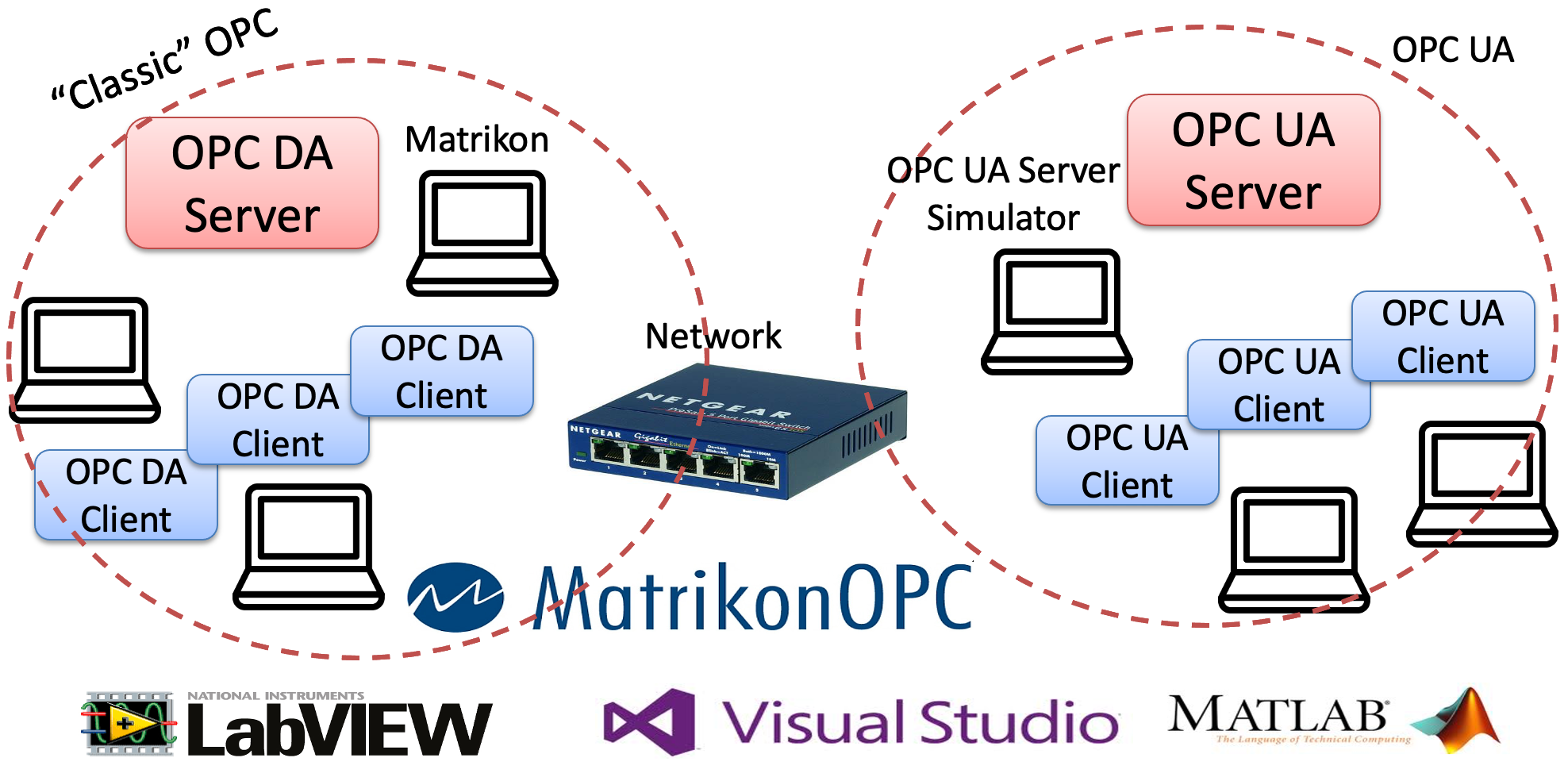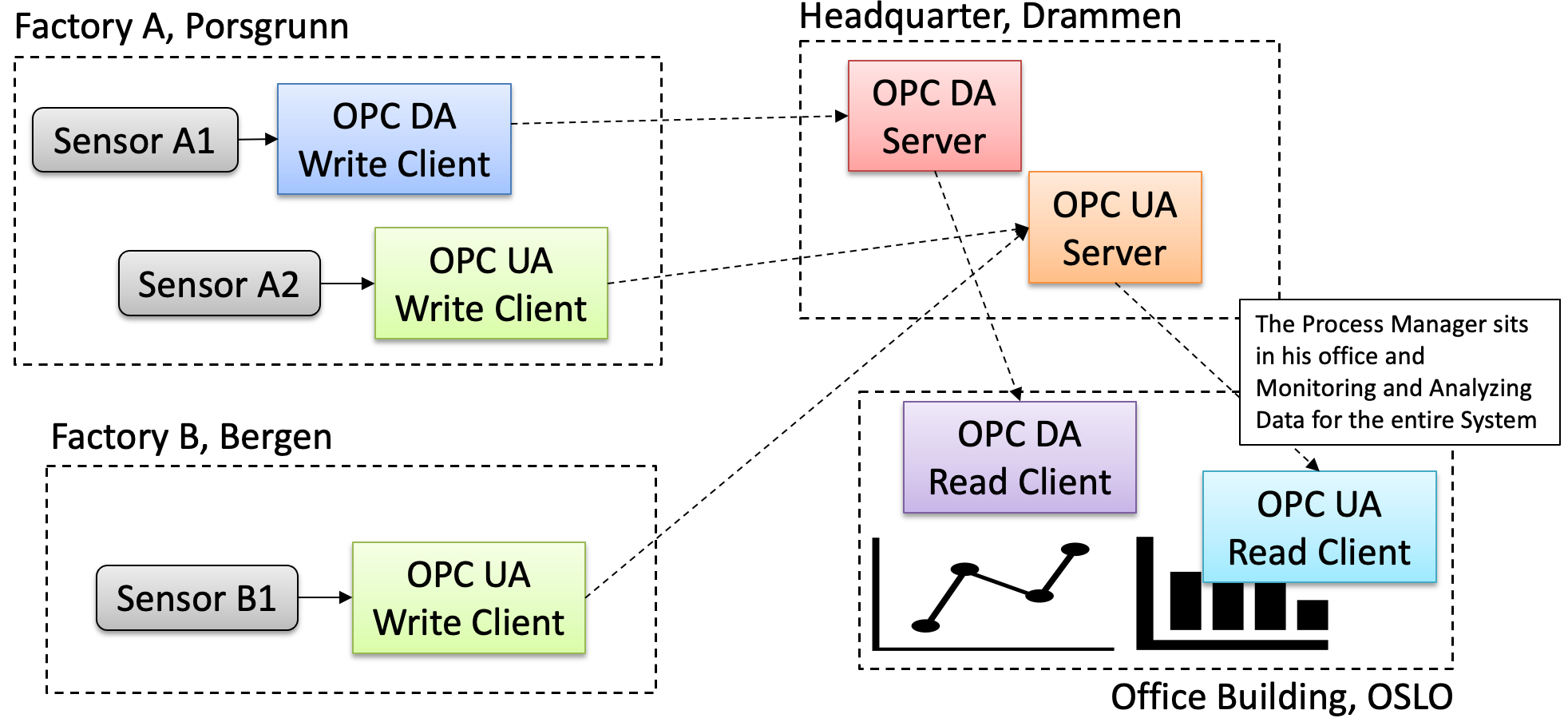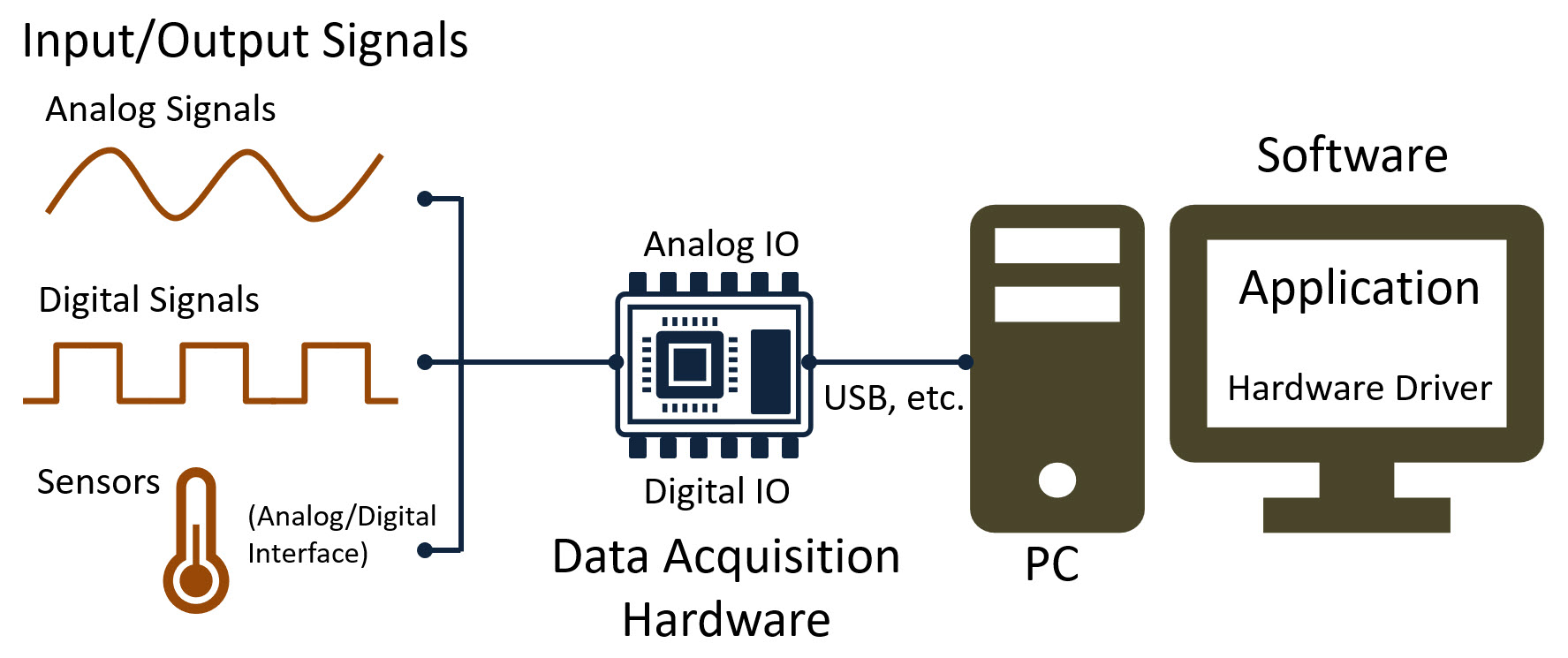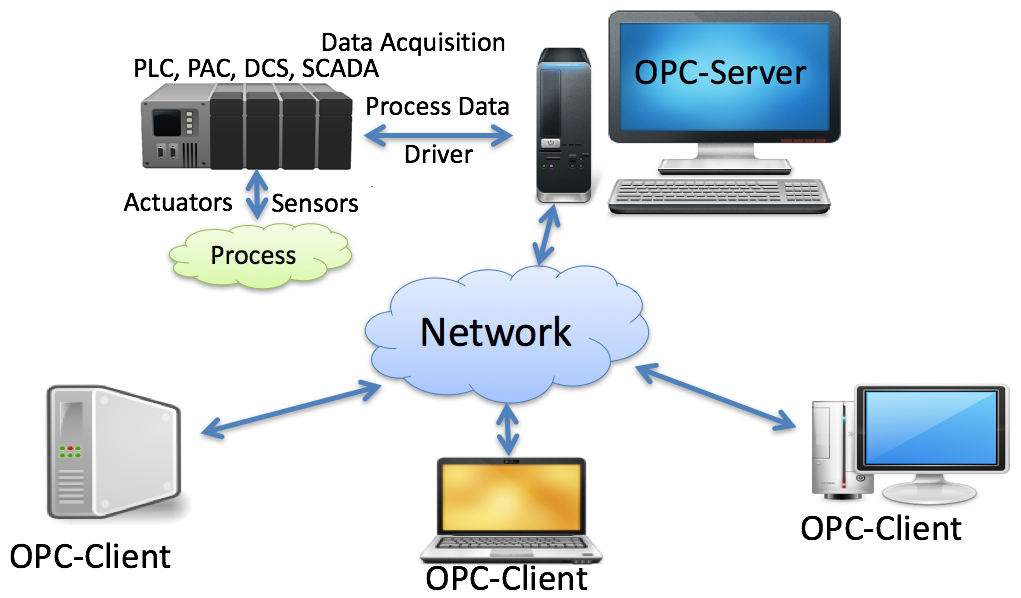1 Introduction
Here we will learn about DAQ and OPC Systems. OPC is an industrial protocol that defines the communication of data between devices from different manufactures. It is one of the most used protocols in the industry today. We will use an OPC Servers from different vendors. We will create different OPC DA clients in different programming languages. We will use LabVIEW to read temperature data from a NI USB-TC01 Thermocouple Measurement Device and send the values to the OPC Server. In addition we will use Visual Studio and C# for getting data from an OPC Server. In addition, we will also use LabVIEW to create an OPC UA Server and different OPC UA clients from scratch.
DAQ and OPC Systems Overview (PDF)
Below you see some examples of OPC, both OPC Classic and the newwe OPC UA:

Use Case Scenario
Here you see a typical Use Case scenario for the DAQ and OPC System:

1.1 Topics
Relevant topics:
- OPC - Her you find lots of Videos, Examples and Code you can download
- Programming, like LabVIEW Programming, Visual Studio/C# and MATLAB Programming
- DAQ
- Datalogging and Monitoring
- Industrial IT
1.2 Hardware
Hardware examples:
- TC-01 Thermocouple Device
- USB-6008 DAQ (or a similar LabVIEW/C# compatible DAQ device)
- TMP36 Temperature Sensors (SparkFun) (can also be found at Elfa and Adafruit)
- Thermistor 10K Temperature Sensor (SparkFun) (can also be found at Elfa)
- PT-100 Sensor
- Switch/Router, Network Equipment
1.3 Software
Software examples:
- LabVIEW - Note! Make sure to use LabVIEW 32bit version (even if you have 64bit operating system) because some features and toolboxes are only supported by the 32 bit version of LabVIEW
- OPC Software - including MatrikonOPC Simulation Server, OPC UA Server Simulator and LabVIEW OPC UA Toolkit
2 LabVIEW
LabVIEW is a graphical programming language, and it has powerful features for simulation, control and DAQ applications.
Typically engineers often create simple LabVIEW VIs that eventually grow out of control, because they don't have the proper structure and best practices. The solution to this problem is organizing your code and data in a way that enables modularity, readability, and reuse.
Some examples are:
- Intuitive GUI (Front Panels): Add Units, Use Controls and Indicators from the same Palette, Resizing the Window size, Don’t use “strong” Colors, etc.
- Structured Code (Block Diagram): Make and use SubVIs, Avoid Spaghetti Code, Resizing the Window size, Use Labels, Always use Project Explorer, use State Machine, etc.
Note! Make sure to use LabVIEW 32bit version (even if you have 64bit operating system) because some features and toolboxes are only supported by the 32 bit version of LabVIEW.
Resources:
LabVIEW Fundamentals (Website) - Recommended!
LabVIEW Programming Guidelines (YouTube) + PowerPoint (PDF)
LabVIEW State Machine (YouTube) + PowerPoint (PDF) + Download Code
3 Data Acquisition (DAQ)
Data Acquisition (DAQ) is the process of collection data from different sensors into a computer. A DAQ System consists of 4 parts: Physical input/output signals, sensors, DAQ device/hardware, driver software and your software application (Application software).

To use the TC-01 Thermocouple device or the USB-6008 DAQ from National Instruments, you need to install the NI-DAQmx driver.
Here you find information about the TC-01 specifications. Here you find the TC-01 User Guide.
Here are some resources for the USB-6008: User Guide and Specifications for USB-6008 and USB-6008 Pinout.
3.1 DAQ with LabVIEW
LabVIEW is a powerful tool for making Data Acquisition applications. Below you find some useful resources.
LabVIEW DAQ Resources:
DAQmx in LabVIEW (YouTube) + PowerPoint (PDF) - Communicate with NI DAQ Devices in LabVIEW. The tutorial shows different ways to use the DAQmx functionality in LabVIEW with practical LabVIEW examples.
TC-01 Thermocouple Temperature Device in LabVIEW (YouTube) + PowerPoint (PDF) - Recommended!
DAQ and I/O Modules in LabVIEW - Introduction (YouTube) + PowerPoint (PDF) - Here we use the USB-6008 DAQ device
DAQ and I/O Modules in LabVIEW - Analog Output (YouTube)
DAQ and I/O Modules in LabVIEW - Analog Input (YouTube)
DAQ and I/O Modules in LabVIEW - Digital Output (YouTube)
DAQ and I/O Modules in LabVIEW - Digital Input (YouTube)
Temperature Sensors:
TMP36 Temperature Sensor Overview
Thermistor Temperature Sensor Overview
TMP36 Temperature Sensor in LabVIEW (YouTube) + PowerPoint (PDF) - Recommended!
Thermistor Temperature Sensor in LabVIEW (YouTube) + PowerPoint (PDF)
Read Temperature Data with Lowpass Filter in LabVIEW (YouTube) + PowerPoint (PDF)
Logging Temperature Data to Text File in LabVIEW (YouTube) + PowerPoint (PDF)
Logging Data from Multiple Sensors to a Text File in LabVIEW (PDF)
3.2 DAQ with Visual Studio/C#
In Visual Studio/C# you can use the most of the DAQ hardware from NI since the DAQmx driver also supports Visual Studio/C# programming.
To use the USB-6008 DAQ from National Instruments in Visual Studio/C#, you need to install the NI-DAQmx driver.
Note! The NI-DAQmx driver do not support the newer .NET Core or .NET 8/9, only NET Framework 4.x. Make sure to select "NI-DAQmx Support for .NET Framework 4.x" and "NI-DAQmx Support for Visual Studio 20xx" during the installation of DAQmx. When creating a new project in Visual Studio, make sure to select the template called "Windows Forms App (.NET Framework)".
Make sure to read the User Guide and Specifications for USB-6008 and USB-6008 Pinout.
Visual Studio/C# DAQ Resources:
Visual Studio/C# and DAQ - Exemplified using DAQ hardware and DAQmx from NI
Temperature Sensor TC-01 with NI DAQmx using Visual Studio (YouTube) + PowerPoint (PDF) - Recommended!
4 OPC
OPC is a standard that defines the communication of data between devices from different manufactures.
OPC requires an OPC server that communicates with one or more OPC clients. OPC allows “plug-and-play”, gives benefits as reduces installation time and the opportunity to choose products from different manufactures.
We have different OPC standards:
- "Real-time” data (OPC DA),
- Historical data (OPC HDA)
- Alarm & Event data (OPC AE)
- OPC UA
- etc.
Below you see a typical OPC scenario with an OPC Server and different OPC Clients:

We will focus on OPC DA and OPC UA. The organization OPC Foundation maintains the OPC standards.
Resources:
OPC with Practical Examples (YouTube) + PowerPoint (PDF) - Recommended!
You find more OPC DA and OPC UA resources below.
5 OPC DA
5.1 MatrikonOPC Simulation Server
MatrikonOPC Simulation Server is free and can be used for testing OPC DA.
Download MatrikonOPC Simulation Server
Problems with installing or using the software?
- Problem: Installer says .NET Framework 3.5 is missing. Solution: Go to Windows Features and turn on .NET Framework 3.5, then run the installer once more.
- Problem: Problems with Matrikon Installation? Solution: Try Disabling the Firewall during the installation.
- Problem: When starting MatrikonOPC Explorer, I get an error indicating there are no servers installed. Solution: In OPC Explorer select View -> Options from the menu bar. On the General Tab select both OPCEnum and Registry as the Browse Methods.
Resources:
OPC DA in LabVIEW (YouTube) + PowerPoint (PDF) - LabVIEW has built-in support for OPC DA using the DataSocket palette.
Note! Make sure to use LabVIEW 32bit version (even if you have 64bit operating system) because the DataSocket feature is only supported by the 32 bit version of LabVIEW.
Below, some alternatives to the MatrikonOPC Simulation Server are presented. If you for some reason are not able to install or have other issues with MatrikonOPC Simulation Server, may can use "OPC Server Simulators" by Integration Objects or "NI OPC Servers" instead. See below.
5.2 OPC Server Simulators
"OPC Server Simulators" by Integration Objects are free OPC server test tools. They allow end-users, developers and integrators to conduct tests with any third party OPC client software. The package consists of an OPC DA/HDA Server and an OPC A&E Server.
Download OPC Server Simulators
5.3 NI OPC Servers
A Demo version of "NI OPC Servers" is included with "LabVIEW DSC Module" or "LabVIEW Real-Time module" (so you may already have it installed on your PC). This one can also be downloaded separately, see below.
Resources:
LabVIEW OPC with NI OPC Servers (PDF)
6 OPC UA
OPC UA (Unified Architecture) is the Next Generation OPC. It is Cross Platform. "Classic" OPC works only for Windows based systems. OPC UA uses a modern Software/Network Architecture (No DCOM problems!) and it makes it easier to transmit and receive data in a modern data network/Internet.
6.1 OPC UA Server Simulator
OPC UA Server Simulator may be a good option when developing and testing OPC UA solutions. This free OPC UA Server tool supports data access and historical access information models of OPC UA. It is also practical to have a OPC UA Client for test purposes. OPC UA Client is a free client tool that supports the main OPC Unified Architecture information models.
Resources:
OPC UA Server Simulator (YouTube) + PowerPoint (PDF) - Recommended!
6.2 UaExpert
UaExpert is an OPC UA Client from Unified Automation. You may use it to test communication with different OPC servers, etc.
UaExpert OPC UA Client (YouTube) + PowerPoint (PDF) - Recommended!
6.3 LabVIEW OPC UA Toolkit
LabVIEW has built-in support for OPC DA using the DataSocket palette. For OPC UA you need the LabVIEW OPC UA Toolkit.
Resources:
LabVIEW OPC UA (YouTube) + PowerPoint (PDF) - Recommended!
7 OPC in MATLAB
MATLAB is a tool for technical computing, computation and visualization in an integrated environment. MATLAB is an abbreviation for MATrix LABoratory, so it is well suited for matrix manipulation and problem solving related to Linear Algebra, Modelling, Simulation and Control applications, etc. MATLAB is developed by MathWorks.
In MATLAB you can use the Industrial Communication Toolbox in order to communicate with an OPC Server. The Industrial Communication Toolbox supports both OPC DA and OPC UA.
The “Industrial Communication Toolbox” is a new Toolbox that is included in “MATLAB R2022a” and newer versions of MATLAB.
The previous name was "MATLAB OPC Toolbox", but they have now combined different communication protocols like OPC, Modbus and MQTT into one new Toolbox.
Resources:
OPC with MATLAB using Industrial Communication Toolbox (YouTube) + PowerPoint (PDF) - Tutorial with OPC DA and OPC UA Examples - Recommended!
MATLAB OPC Toolbox (YouTube) + PowerPoint (PDF) - Tutorial with OPC DA Examples
OPC UA Server Simulator (YouTube) + PowerPoint (PDF) - Tutorial with OPC UA Examples
Note! The Toolbox has changed name from "MATLAB OPC Toolbox" to Industrial Communication Toolbox. The principles and the functionality are more or less the same.
8 OPC in Visual Studio and C#
Microsoft Visual Studio is an integrated development environment (IDE) from Microsoft. It can be used to develop console and graphical user interface applications along with Windows Forms applications, web sites, web applications, and web services in both native code together with managed code for all platforms supported by Microsoft Windows.
Introduction to Visual Studio and C# (YouTube) + PowerPoint (PDF) - For those who are new to Visual Studio and C#
C# Tutorial (w3schools.com) (Website)
Visual Studio don't have any built-in support for OPC. This means you typically need to use a 3.party package from another vendor. Some of these packages are shown below with some practical examples.
Resources:
OPC UA in Visual Studion/C#:
OPC UA with Visual Studio and C# (YouTube) + PowerPoint (PDF) - Recommended!
OPC DA in Visual Studion/C#:
OPC in Visual Studio 2019 and Measurement Studio 2019 (YouTube) + PowerPoint (PDF)
Distributed System Manager - Workaround (YouTube) + PowerPoint (PDF)
9 OPC in Python
Python is an open source and cross-platform programming language, that has become increasingly popular over the last ten years. It was first released in 1991.
Python is a mult-purpose programming languages (due to its many extensions), examples are scientific computing and calculations, simulations, web development (using, eg., the Django Web framework), etc.
Lots of different packages and libraries exist for both OPC DA and OPC UA in Python.